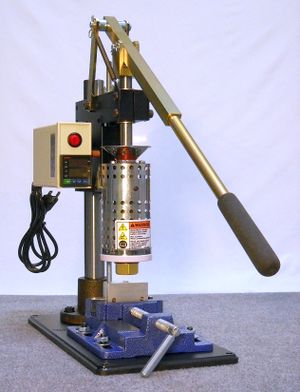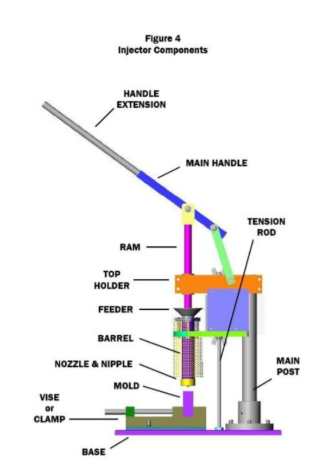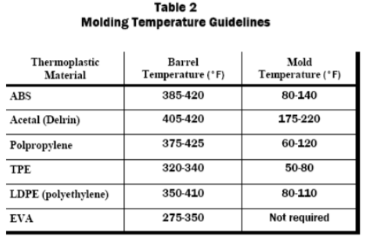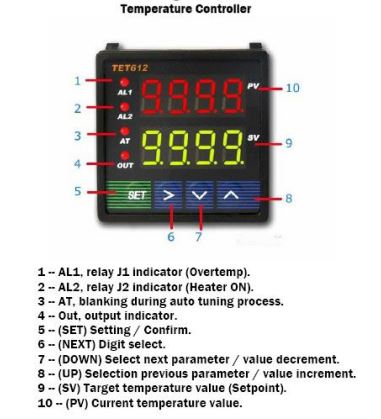Difference between revisions of "Injection Molding Machine"
| Line 13: | Line 13: | ||
|Has model=150A | |Has model=150A | ||
|Has serial number=D00709 | |Has serial number=D00709 | ||
| − | |Has ace= | + | |Has ace=Needed;Makerhub@georgefox.edu |
}} | }} | ||
[[{{#show: {{FULLPAGENAME}}|?Has icon|link=none}}|140px|left|top|{{#show: {{FULLPAGENAME}}|?Has icondesc}}]] | [[{{#show: {{FULLPAGENAME}}|?Has icon|link=none}}|140px|left|top|{{#show: {{FULLPAGENAME}}|?Has icondesc}}]] | ||
Revision as of 09:47, 29 September 2022
Make: Pim-shooter
Model: 150A
Serial Number: D00709
Ace: Sam Manina (smanina22@georgefox.edu).
Location: The Vault
Description
The Model 150A PIM-SHOOTER™ by LNS Technologies is a bench model injection molder designed for production of thermoplastic parts in quantities required for making prototypes and low-volume production (or higher-volume production of small parts). Due to the machine’s small size it is limited to producing small parts, but it is capable of producing these parts efficiently, accurately (as accurate as the mold is), and repeatedly. The plastic shot size is 1.1 cubic inch Max.
Documentation
Terminology
Flash - This is when the two halves of a molding tool are not properly sealed, causing molten plastic to leak out of the part cavity
Sprue - The main channel guiding the molten plastic from the nozzle of the injection molder into the part cavity.
Runners - Subchannels that branch off from the sprue and into the part cavities. These are used for mold tools that contain multiple part cavities.
Gate - The thin section connecting a runner or sprue to the part cavity
Shot - The volume of material needed to fill the mold cavity.
Injection Molding Machine User Manual
Training
Operation
The injection molder works by melting plastic pellets within a heated barrel to a specific temperature, and using a ram plunger to force the molten plastic through a nozzle, into a mold cavity.
Demonstration
For the injection molder demonstration, a pre-existing mold will be provided and the person must successfully injection mold the part. They should demonstrate proper adjustment of height to fit the mold, setting up for injection (filling the hopper, setting the temperature, and aligning the mold under the nozzle), injecting, and removal of the mold and part from the mold.
General Procedure
- Setup
- You will need to setup the molding machine using the following steps and charts. Temperatures for different plastics can be found in the table below. Make sure to wear gloves and safety glasses while using this machine.
- First we need to adjust the height for the mold being used by following these steps.
- Set the mold clamps to measure the gap.
- Loosen the height adjustment bolts on the top holder using a 6mm Allen Wrench.
- Loosen both tension nuts, and turn the lower tension nut to move the top holder up and down the main post. This will determine the height of the machine.
- Raise or lower the top holder so that there is a gap between the nozzle and the mold sprue (this allows adding and removing the mold), but of no more than ½”.
- Tighten height adjustment bolts, and verify that the nozzle aligns well with the mold sprue.
- Tighten the upper and lower tension nuts.
- Molding
- Turn on the power switch.
- Make sure the SV value is correct on the temp controller for the type of material you are using. Adjust the temp controller using the setting buttons if the SV value needs adjusting.
- Wait for the PV value to reach the SV value.
- Now add pellets to the feeder.
- Wait several minutes for the pellets to melt. If you want to preheat the mold now is the time.
- You should see a small amount of plastic ooze from the nozzle
- Make sure the mold is clamped tight and the nozzle nipple is aligned with the mold sprue.
- Scrape away any oozing plastic from the nozzle using a screwdriver or similar tool. This helps keep plastic chunks out of the mold.
- With a smooth linear motion push down on the handle and fill the mold.
- Hold pressure on the handle for an extra few seconds. This will help reduce shrinking of the plastic in the mold.
- Retract the handle all of the way to remove the plunger and give access to load more pellets.
- You can now remove the mold and separate the halves.
Safety
- Parts of the injection molding machine get very hot and could burn you. You need to wear gloves while working with the machine and molds.
- Never attempt to use PVC or other materials not approved for use with this machine. PVC will produce toxic fumes when heated.
Certification
Troubleshooting
It may take some time to learn how much pressure to apply to the handle when filling a mold. If you press too hard you will end up with lots of plastic flash on your finished piece as material will ooze out between the mold halves. If you don't press hard enough you could end up with an air pocket left in the mold.
If you run into an issue with the material not flowing properly make sure that you are heating the material to the correct temperature and allowing enough time for the plastic to melt.
Maintenance
General maintenance
The machine should to be cleaned on a regular basis and mechanical parts should be checked for wear as well as loosening of any parts.
Specific Maintenance Tasks
| Maintenance Procedure | Frequency | Done By |
|---|---|---|
| Clean up plastic overflow | When used | Student |




